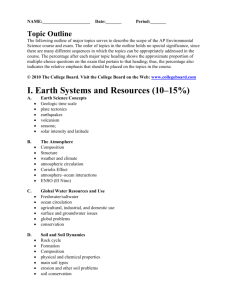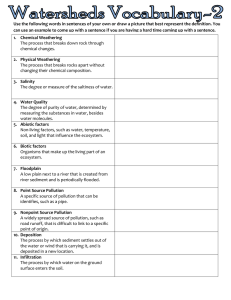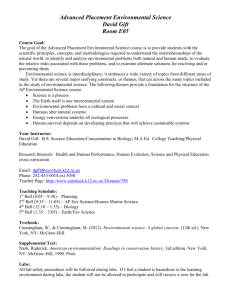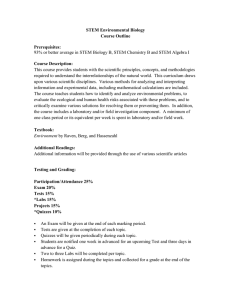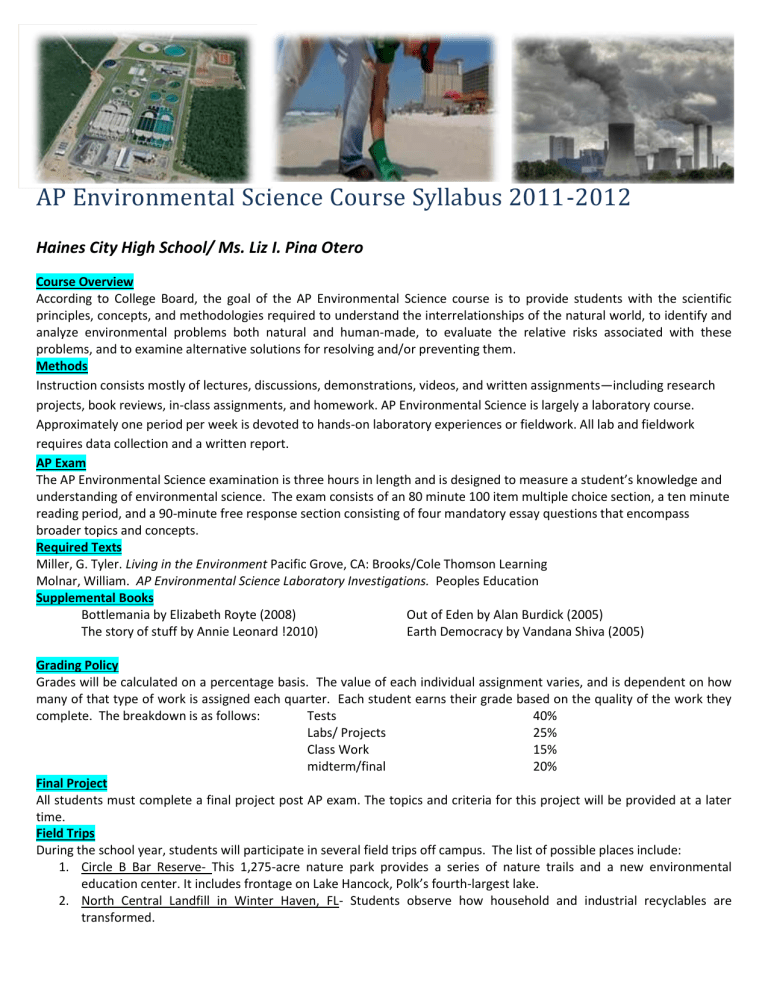
AP Environmental Science Course Syllabus 2011-2012 Haines City High School/ Ms. Liz I. Pina Otero Course Overview According to College Board, the goal of the AP Environmental Science course is to provide students with the scientific principles, concepts, and methodologies required to understand the interrelationships of the natural world, to identify and analyze environmental problems both natural and human-made, to evaluate the relative risks associated with these problems, and to examine alternative solutions for resolving and/or preventing them. Methods Instruction consists mostly of lectures, discussions, demonstrations, videos, and written assignments—including research projects, book reviews, in-class assignments, and homework. AP Environmental Science is largely a laboratory course. Approximately one period per week is devoted to hands-on laboratory experiences or fieldwork. All lab and fieldwork requires data collection and a written report. AP Exam The AP Environmental Science examination is three hours in length and is designed to measure a student’s knowledge and understanding of environmental science. The exam consists of an 80 minute 100 item multiple choice section, a ten minute reading period, and a 90-minute free response section consisting of four mandatory essay questions that encompass broader topics and concepts. Required Texts Miller, G. Tyler. Living in the Environment Pacific Grove, CA: Brooks/Cole Thomson Learning Molnar, William. AP Environmental Science Laboratory Investigations. Peoples Education Supplemental Books Bottlemania by Elizabeth Royte (2008) Out of Eden by Alan Burdick (2005) The story of stuff by Annie Leonard !2010) Earth Democracy by Vandana Shiva (2005) Grading Policy Grades will be calculated on a percentage basis. The value of each individual assignment varies, and is dependent on how many of that type of work is assigned each quarter. Each student earns their grade based on the quality of the work they complete. The breakdown is as follows: Tests 40% Labs/ Projects 25% Class Work 15% midterm/final 20% Final Project All students must complete a final project post AP exam. The topics and criteria for this project will be provided at a later time. Field Trips During the school year, students will participate in several field trips off campus. The list of possible places include: 1. Circle B Bar Reserve- This 1,275-acre nature park provides a series of nature trails and a new environmental education center. It includes frontage on Lake Hancock, Polk’s fourth-largest lake. 2. North Central Landfill in Winter Haven, FL- Students observe how household and industrial recyclables are transformed. 3. Lakeland Highlands Scrub- One of the first acquisitions for Polk County’s Environmental Lands Program and undoubtedly one of the more heavily used. It protects 160 acres of untouched habitats along the Lakeland Ridge. Students observe 300 square miles along the west side of Polk County, forming a natural watershed divide between the Hillsborough and Alafia Rivers. 4. City of Bartow Waste Water treatment Plant- students observe how raw sewage is recycled 5. Everglades National Park – Students study water quality issues of the Florida Everglades WebQuests/Internet Activities Students will take advantage of the internet and complete several webquests that correlate with the AP Environmental Science curriculum. A few of the webquests include: ● Ecological Footprint Calculations ●GIZMOS earthquakes ● Biome and Climatogram Activity ●GIZMOS plate tectonics Videos During the school year students will be able to view several videos related to the concept in the AP environmental Science course. The list of possible videos include: The Meatrix Cane Toads Home Dirt Food Inc. CNN – Planet in Peril – Battle lines The Eleventh Hour The Cove The Lorax The Inconvenient Truth Course Outline A detailed course outline can be viewed at the College Board website. The time frame for each is an approximation and may fluctuate depending on time. Unit 1 – Earth Systems and Resources (10-15%) 6 weeks CONCEPTS: A. Introduction to a laboratory science: lab tools, energy units, conversions, measurements, scientific method, exponents, lab safety, scientific notation, percent change over time, metric conversions and spreadsheet applications. B. The Geosphere- Geologic time scale; plate tectonics, earthquakes, volcanism; seasons; solar intensity and latitude - Rock cycle; formation; composition; physical and chemical properties; main soil types; erosion and other soil problems; soil conservation C. The Atmosphere – Composition; structure; weather and climate; atmospheric circulation and the Coriolis Effect; atmosphere–ocean interactions; ENSO D. The Hydrosphere - Freshwater/saltwater; ocean circulation; agricultural, industrial, and domestic use; surface and groundwater issues; global problems; conservation METHODS: ● Living in the Environment – Sections of Chapters 1, 3, 5, 13, 14, 15, 17, 19, 20, 25 ● Labs: 1. Goldfish Cracker Lab: Population and Natural Resources/Scientific Method Intro: Students learn about the power of doubling and how it relates to population issues in environmental science. 2. Tragedy of the Commons: Students learn about the consumption of “common” resources and the consequences of such actions. 3. Soil Chemical Properties: Students will study a sample of soil from a golf course, the Everglades and their backyard. Students will measure the content of several chemicals and determine the environmental consequences of having too much or too little of the chemicals on native habitats. 4. Soil Physical Properties Students will study, analyze and measure the physical properties of the soil mentioned in the 5. Chemical Properties: Students will draw conclusions from their findings. ● Technology: Gizmo/Earthquake Seismic Waves ● Videos: The Lorax, Home and Dirt ● Unit 1 – Formal assessment – AP exam format Unit 2 – The Biosphere (10-15%) 3 weeks CONCEPTS: A. Ecosystem Structure - Biological populations and communities; ecological niches; interactions among species; keystone species; species diversity and edge effects; major terrestrial and aquatic biomes B. Energy Flow - Photosynthesis and cellular respiration; food webs and trophic levels; ecological pyramids C. Ecosystem Diversity - Biodiversity; natural selection; evolution; ecosystem services D. Natural Ecosystem Change - Climate shifts; species movement; ecological succession E. Natural Biogeochemical Cycles - Carbon, nitrogen, phosphorus, sulfur, water, conservation of matter METHODS: ● Living in the Environment –Sections of Chapters 2-7, 10, 11, 12 ● Labs: 1. Energy transfer - Using Vanessa cardui cultures, students plot the change in mass of a controlled environment and determine the efficiency of energy transfer from the food medium to the larva and the adult butterfly 2. Comparison of GPP and NPP Lab – Using grasses over time students calculate GPP and NPP as energy and dry mass 3. Growth Rate and Carrying Capacity - Students use inquiry-based procedures to set up micro-environmental cultures of Lemna and explore the effects of pH, light, salinity, excess phosphorus, excess nitrogen, and temperature on growth rate and carrying capacity 4. Ecosystem Diversity – Using self-developed scientific methodologies; students will explore complexities of biodiversity with habitat cards, sticky traps and bait Analysis of leaf litter animals from local areas ●Project; Build an Ecosystem Project – Students create an artificial ecosystem, manipulate one variable and observe the ecosystem over a period of time. ● Field trip: Circle B reserve: Ecosystem Field Walk –Students will use field guides to identify native species of plants, trees, birds and insects found on the school’ nature trail. ● Videos: Food Inc. and the Meatrix ● Unit 2 – Formal assessment – AP exam format End of 1st Quarter Unit 3 – Population (10-15%) 3 weeks CONCEPTS: A. Population Biology Concepts - Population ecology; carrying capacity; reproductive strategies; survivorship B. Human Population Dynamics - Historical population sizes; distribution; fertility rates; growth rates and doubling times; demographic transition; age-structure diagrams C. Population Size- sustainability and national policies D. Impacts of population growth - Hunger; disease; economic effects; resource use; habitat destruction METHODS: ● Living in the Environment –Sections of chapters 7- 12, 25 ● Labs: 1. Duckweed Population Growth, Aquatic Species Diversity, Human survivorship changes 2.Population size Strategies for sustainability; case studies; national policies, Ecological Footprint ● Field trip: North Central Landfill in Winter Haven, FL ● Videos: Cane toads ● Unit 3 – Formal assessment – AP exam format Unit 4 – Land and Water Use (10-15%) 6 weeks CONCEPTS: A. Agriculture - Human nutritional requirements; types of agriculture; Green Revolution; genetic engineering and crop production; deforestation; irrigation; sustainable agriculture B. Controlling pests -Types of pesticides; costs and benefits of pesticide use; integrated pest management; relevant laws C. Forestry - Tree plantations; old growth forests; forest fires; forest management; national forests D. Rangelands - Overgrazing; deforestation; desertification; rangeland management; federal rangelands E. Urban land development - Planned development; suburban sprawl; urbanization F. Transportation infrastructure - Federal highway system; canals and channels; road-less areas; ecosystem impacts G. Public and federal lands - Management; wilderness areas; national parks; wildlife refuges; forests; wetlands H. Land conservation options - Preservation; remediation; mitigation; restoration, sustainable land-use strategies I. Mining - Mineral formation; extraction; global reserves; relevant laws and treaties J. Fishing - Fishing techniques; overfishing; aquaculture; relevant laws and treaties K. Global Economics - Globalization; World Bank; Tragedy of the Commons; relevant laws and treaties METHODS: Living in the Environment –Chapters 13, 14, 15 ● Labs: Soil Salinity, Soil and acid precipitation, effect of acid deposition in aquatic ecosystems, turbidity, Range of tolerance ● Field trip: City of Bartow Waste Water treatment Plant● Videos: The Inconvenient Truth and The cove ● Unit 4 – Formal assessment – AP exam format End of 2nd Quarter- MIDTERM EXAM Unit 5 – Energy Resources and Consumption (10-15%) 3 weeks CONCEPTS: A. Energy Concepts - Energy forms; power; units; conversions; Laws of Thermodynamics B. Energy Consumption a. History - Industrial Revolution; exponential growth; energy crisis b. Present global energy use c. Future energy needs C. Fossil Fuel Resources and Use - Formation of coal, oil, and natural gas; extraction/purification methods; world reserves and global demand; synfuels; environmental advantages/disadvantages of sources D. Nuclear Energy - Nuclear fission process; nuclear fuel; electricity production; nuclear reactor types; environmental advantages/disadvantages; safety issues; radiation and human health; radioactive wastes; nuclear fusion E. Hydroelectric Power - Dams; flood control; salmon; silting; other impacts F. Energy Conservation - Energy efficiency; CAFE standards; hybrid electric vehicles; mass transit G. Renewable Energy - Solar energy; solar electricity; hydrogen fuel cells; biomass; wind energy; small-scale hydroelectric; ocean waves and tidal energy; geothermal; environmental advantages/disadvantages METHODS: Living in the Environment – Sections of chapters 15-17 ● Labs: Oil Spill lab. Duckweed Population Growth, Aquatic Species Diversity, Human survivorship changes, Population size Strategies for sustainability; case studies; national policies, Ecological Footprint, Indoor energy conservation ● Field trip: Florida Everglades (as future coal deposits) ● Videos: The eleventh hour ● Unit 5 – Formal assessment – AP exam format Unit 6 – Pollution (25-30%) 6 weeks CONCEPTS: A. Pollution Types a. Air pollution -Sources—primary and secondary; major air pollutants; measurement units; smog; acid deposition— causes and effects; heat islands and temperature inversions; indoor air pollution; remediation and reduction strategies; Clean Air Act and other relevant laws b. Noise pollution - Sources; effects; control measures c. Water pollution - Types; sources, causes, and effects; cultural eutrophication; groundwater pollution; maintaining water quality; water purification; sewage treatment/septic systems; Clean Water Act and other relevant laws B. Solid waste - Types; disposal; reduction a. Impacts on the Environment and Human Health b. Hazards to human health - Environmental risk analysis; acute and chronic effects; dose-responserelationships; air pollutants; smoking and other risks c. Hazardous chemicals in the environment - Types of hazardous waste; treatment/disposal of hazardous waste; cleanup of contaminated sites; biomagnification; relevant laws C. Economic Impacts - Cost-benefit analysis; externalities; marginal costs; sustainability METHODS: Living in the Environment – Sections of chapters 18-22 ● Labs: Air pollution by fossil fuel consumption, acid deposition, testing soil productivity, quality of natural waters ● Videos: Home ● Unit 6 – Formal assessment – AP exam format End of 3rd Quarter Unit 7 – Global Change (10-15%) 4 weeks CONCEPTS: A. Stratospheric Ozone - Formation of stratospheric ozone; ultraviolet radiation; causes of ozone depletion; effects of ozone depletion; strategies for reducing ozone depletion; relevant laws and treaties B. Global Warming - Greenhouse gases and the greenhouse effect; impacts and consequences of global warming; reducing climate change; relevant laws and treaties C. Loss of Biodiversity a. Habitat loss; overuse; pollution; introduced species; endangered and extinct species b. Maintenance through conservation METHODS: Living in the Environment – Sections of chapters 23-26 ● Labs: long – term temperature trends over/in different man-made surfaces, extrapolate world-wide impacts ● Videos: CNN – Planet in Peril – Battle lines ● Unit 7 – Formal assessment – AP exam format FINAL EXAM before AP EXAM in May Final Project after AP Exam: Unit 8- Environment and Society: Trade-Offs and Decision Making 4 weeks and throughout the year A. Economic Forces 1. cost-benefit analysis 2. marginal costs 3. ownership and externalized costs B. Cultural and Aesthetic Considerations C. Environmental Ethics D. Environmental Laws and Regulations (International, National, and Regional) E. Issues and Options (conservation, preservation, restoration, remediation, sustainability, mitigation) ****Important note: rubrics will be provided for all labs, projects, short answers, movies and fieldtrip activities.
